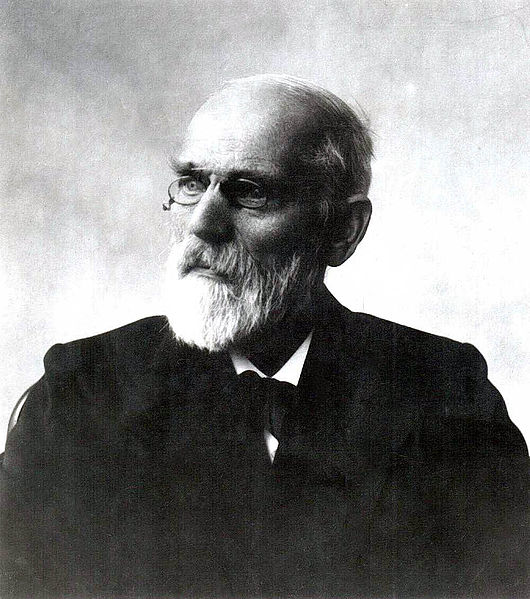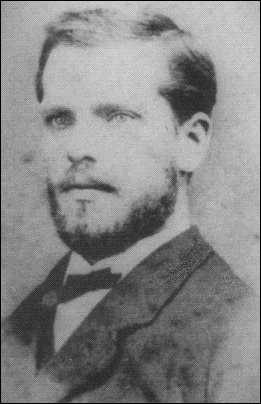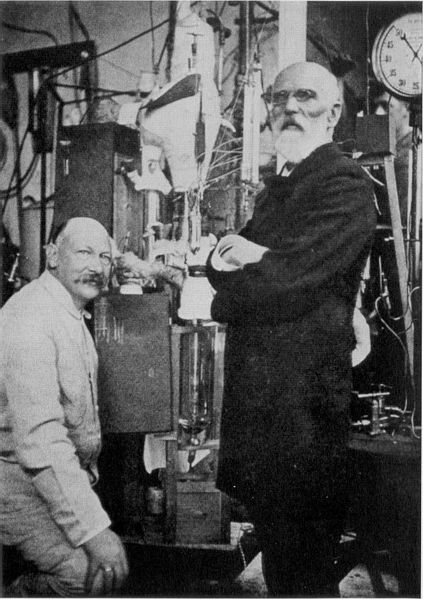<Back to Index>
- Physicist Johannes Diderik van der Waals, 1837
PAGE SPONSOR



Johannes Diderik van der Waals (November 23, 1837 – March 8, 1923) was a Dutch theoretical physicist and thermodynamicist famous for his work on an equation of state for gases and liquids.
His name is primarily associated with the van der Waals equation of state that describes the behavior of gases and their condensation to the liquid phase. His name is also associated with van der Waals forces (forces between stable molecules), with van der Waals molecules (small molecular clusters bound by van der Waals forces), and with van der Waals radii (sizes of molecules).
He became the first physics professor of the University of Amsterdam
when it opened in 1877 and won the 1910 Nobel Prize in physics.
Johannes Diderik was the oldest of ten children born to Jacobus van der Waals and Elisabeth van den Berg. His father was a carpenter in the Dutch city of Leiden. As was usual for working class children in the 19th century, he did not go to the kind of secondary school that would have given him the right to enter university. Instead he went to a school of “advanced primary education”, which he finished at the age of fifteen. He then became a teacher's apprentice in an elementary school. Between 1856 and 1861 he followed courses and gained the necessary qualifications to become a primary school teacher and head teacher.
In 1862, he began to attend lectures in mathematics, physics and astronomy at the University in his city of birth, although he was not qualified to be enrolled as a regular student in part because of his lack of education in classical languages. However, the University of Leiden had a provision that enabled outside students to take up to four courses a year. In 1863 the Dutch government started a new kind of secondary school (HBS, a school aiming at the children of the higher middle classes). Van der Waals — at that time head of an elementary school — wanted to become a HBS teacher in mathematics and physics and spent two years studying in his spare time for the required examinations.
In 1865, he was appointed as a physics teacher at the HBS in Deventer and in 1866, he received such a position in The Hague,
which is close enough to Leiden to allow van der Waals to resume his
courses at the University there. Just before moving to Deventer Johannes
Diderik married the eighteen year old Anna Magdalena Smit, in September
1865.
Van der Waals still lacked the knowledge of the classical languages that would have given him the right to enter university as a regular student and to take examinations. However, it so happened that the law regulating the university entrance was changed and dispensation from the study of classical languages could be given by the minister of education. Van der Waals was given this dispensation and passed the qualification exams in physics and mathematics for doctoral studies.
At Leiden University, on June 14, 1873, he defended his doctoral thesis Over de Continuiteit van den Gas en Vloeistoftoestand (on the continuity of the gaseous and liquid state) under Pieter Rijke. In the thesis, he introduced the concepts of molecular volume and molecular attraction.
In September 1877 van der Waals was appointed the first professor of
physics at the newly founded Municipal University of Amsterdam. Two of
his notable colleagues were the physical chemist Jacobus Henricus van 't
Hoff and the biologist Hugo de Vries. As could be expected from a
former elementary school teacher, van der Waals was an excellent and
impressive lecturer.
Until his retirement at the age of 70 van der Waals remained at the
Amsterdam University. He was succeeded by his son Johannes Diderik van
der Waals, Jr., who also was a theoretical physicist. At the age of 72,
(in 1910) van der Waals was awarded the Nobel Prize in physics. He died
at the age of 85 on March 8, 1923.
The main interest of van der Waals was in the field of thermodynamics. He was much influenced by Rudolf Clausius' 1857 treatise entitled Über die Art der Bewegung, welche wir Wärme nennen (On the Kind of Motion which we Call Heat). Van der Waals was later greatly influenced by the writings of James Clerk Maxwell, Ludwig Boltzmann and Willard Gibbs. Clausius' work led him to look for an explanation of Thomas Andrews' experiments that had revealed, in 1869, the existence of critical temperatures in fluids. He managed to give a semi - quantitative description of the phenomena of condensation and critical temperatures in his 1873 thesis, entitled Over de Continuïteit van den Gas - en Vloeistoftoestand (On the continuity of the gas and liquid state). This dissertation represented a hallmark in physics and was immediately recognized as such, e.g., by James Clerk Maxwell who reviewed it in Nature in a laudatory manner.
In this thesis he derived the equation of state bearing his name. This work gave a model in which the liquid and the gas phase of a substance merge into each other in a continuous manner. It shows that the two phases are of the same nature. In deriving his equation of state van der Waals assumed not only the existence of molecules (the existence of atoms was disputed at the time), but also that they are of finite size and attract each other. Since he was one of the first to postulate an intermolecular force, however rudimentary, such a force is now sometimes called a van der Waals force.
A second great discovery was published in 1880, when he formulated the Law of Corresponding States. This showed that the van der Waals equation of state can be expressed as a simple function of the critical pressure, critical volume, and critical temperature. This general form is applicable to all substances (van der Waals equation.) The compound - specific constants a and b in the original equation are replaced by universal (compound - independent) quantities. It was this law which served as a guide during experiments which ultimately led to the liquefaction of hydrogen by James Dewar in 1898 and of helium by Heike Kamerlingh Onnes in 1908.
In 1890, van der Waals published a treatise on the Theory of Binary Solutions in the Archives Néerlandaises. By relating his equation of state with the Second Law of Thermodynamics, in the form first proposed by Willard Gibbs, he was able to arrive at a graphical representation of his mathematical formulations in the form of a surface which he called Ψ (Psi) surface following Gibbs, who used the Greek letter Ψ for the free energy of a system with different phases in equilibrium.
Mention should also be made of van der Waals' theory of capillarity which in its basic form first appeared in 1893. In contrast to the mechanical perspective on the subject provided earlier by Pierre - Simon Laplace, van der Waals took a thermodynamic approach. This was controversial at the time, since the existence of molecules and their permanent, rapid motion were not universally accepted before Jean Baptiste Perrin's experimental verification of Albert Einstein's theoretical explanation of Brownian motion.
He married Anna Magdalena Smit in 1865, and the couple had three daughters (Anne Madeleine, Jacqueline Elisabeth (poet), Johanna Diderica) and one son, the physicist Johannes Diderik, Jr. Van der Waals' nephew Peter van der Waals was a cabinet maker and a leading figure in the Sapperton, Gloucestershire, school of the Arts and Crafts movement. His wife died of tuberculosis at 34 years old in 1881. Van der Waals never remarried and was so shaken by the death of his wife that he did not publish anything for about a decade. Van der Waals died in Amsterdam on March 8, 1923, one year after his daughter Jacqueline had died.
Van der Waals received numerous honors and distinctions, besides winning the 1910 Nobel Prize in Physics. He was awarded an honorary doctorate of the University of Cambridge; was made honorary member of the Imperial Society of Naturalists of Moscow, the Royal Irish Academy and the American Philosophical Society; corresponding member of the Institut de France and the Royal Academy of Sciences of Berlin; associate member of the Royal Academy of Sciences of Belgium; and foreign member of the Chemical Society of London, the National Academy of Sciences of the U.S.A., and of the Accademia dei Lincei of Rome. Van der Waals was a member of the Koninklijke Nederlandse Akademie van Wetenschappen (Royal Netherlands Society of Arts and Sciences). From 1896 until 1912, he was secretary of this society.